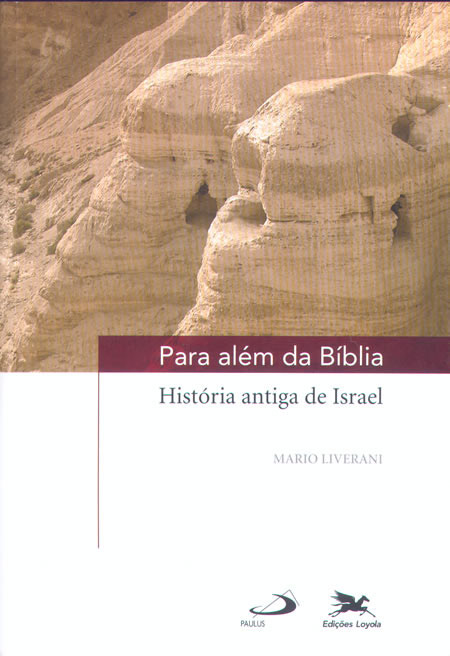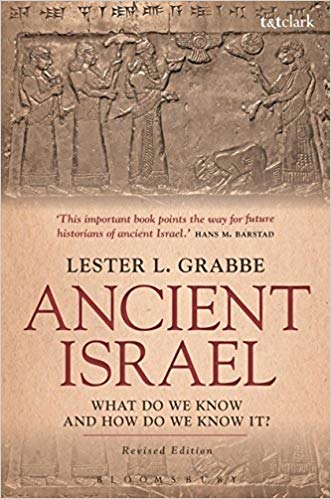:. A História de Israel e Judá na pesquisa atual I
:. A História de Israel e Judá na pesquisa atual II
:. A História de Israel e Judá na pesquisa atual III
:. A História de Israel e Judá na pesquisa atual IV
:. A História de Israel e Judá na pesquisa atual V
TOBOLOWSKY, A. Israelite and Judahite History in Contemporary Theoretical Approaches. Currents in Biblical Research, Vol. 17(1), 2018, p. 33-58.
Este artigo de Andrew Tobolowsky, História israelita e judaíta em abordagens acadêmicas contemporâneas, analisa a evolução do estudo das histórias de Israel e Judá, com ênfase nos últimos dez anos. Durante esse período, tem havido um interesse crescente em evidências extrabíblicas como o principal meio de construir histórias abrangentes, e um renascimento do interesse em teorias pós-modernas. Este estudo oferece uma discussão geral sobre as tendências da última década, considerando a possibilidade dos autores judaítas só terem assumido uma identidade israelita após a queda de Israel [= reino do norte]. Depois de mostrar as principais tendências nos estudos da Bíblia e da História de Israel de modo genérico, o autor aborda o período pré-monárquico, a monarquia unida, os dois reinos de Israel e Judá e o exílio babilônico e, por fim, a época persa.
This article surveys developments in the study of the histories of ancient Israel and Judah with a focus on the last ten years. Over that period there has been an increased focus on extrabiblical evidence, over biblical text, as the primary means of constructing comprehensive histories, and a revival of interest in post-modern and linguistic-turn theories with respect to establishing what kinds of histories should be written. This study offers a general discussion of the last decade’s trends; an inquiry into the possibility that Judahite authors only assumed an Israelite identity after the fall of Israel; and an era-by-era investigation of particular developments in how scholars think about the various traditional periods of Israelite and Judahite history. The latter inquiry spans the pre-monarchical period to the Persian period.
Andrew Tobolowsky: Visiting Assistant Professor at the College of William and Mary in Williamsburg, Virginia, USA.
Sempre que o assunto tiver sido tratado em minha página, Ayrton’s Biblical Page, ou neste blog, Observatório Bíblico, colocarei um link. As principais obras citadas terão links para a Amazon.com.br. O texto em português é um resumo e uma tradução livre minha. O texto em inglês na parte final do post é citação do artigo. A publicação será feita em 5 postagens.
4. Os dois reinos, Israel e Judá, e o exílio babilônico – The Period of the Dual Monarchies and the Exile
Qual pesquisador ousaria, cinquenta anos atrás, escrever uma história que resgata o reino “esquecido” de Israel Norte como uma realidade totalmente distinta e independente de Judá? A falência da ideia de uma monarquia unida, vista no item anterior, ajudou a encaminhar a pesquisa nesta direção. Quer um bom exemplo? Israel Finkelstein em seu livro Le Royaume biblique oublié, de 2013, em francês, publicado no mesmo ano também em inglês como The Forgotten Kingdom: The Archaeology and History of Northern Israel, e em português, em 2015, como O reino esquecido: arqueologia e história de Israel Norte. A mesma coisa pode ser dita de Daniel E. Fleming, 2012.
Abordagens que usam fontes extrabíblicas, especialmente neoassírias, são as que mais claramente recuperam Israel Norte como um lugar historicamente distinto de Judá. Assim Mario Liverani, em 2003 [Para além da Bíblia: História antiga de Israel. São Paulo: Loyola/Paulus, 2008] e Axel Knauf & Philippe Guillaume, 2016.
Muitos ensaios apresentados em congressos têm sido publicados. Por exemplo, as obras coordenadas por Lester L. Grabbe, em 2007 e 2011, resultantes das discussões do Seminário Europeu sobre Metodologia Histórica que durou 16 anos reunindo um grupo seleto de especialistas e que abordou algumas das questões mais importantes da História de Israel [confira as muitas publicações do Seminário nesta bibliografia aqui]. Sem nos esquecermos das várias obras do próprio Lester L. Grabbe, como, por exemplo, Ancient Israel: What Do We Know and How Do We Know It? London: T & T Clark, 2007 [Revised Edition: 2017].
Valiosas contribuições sobre os séculos X e IX a.C. estão também na obra coordenada por H. G. M. Williamson, em 2007. Para o século VII a.C., vale conferir os estudos de C. L. Crouch, publicados em 2014 (aqui e aqui).
Para a época do exílio e além, Oded Lipschits publicou, com outros autores, uma série de estudos sobre Judá e os judeus da época neobabilônica (2003 e 2005) e da época persa (2006 e 2011). Ainda sobre o exílio e a restauração: Brad E. Kelle et alii, 2011; Gary N. Knoppers et alii, 2009; Bob Becking et alii, 2009.
É importante notar que o mito da terra vazia foi denunciado em vários estudos. A ideia de que com o exílio dos judaítas para a Babilônia em 586 a.C. o território de Judá teria ficado vazio não se sustenta. Isto foi abordado desde 1996 por Hans M. Barstad. O tema voltou a ser tratado por ele, em 2008, e por outros, como Bob Becking et alii, em 2009; J. A. Middlemas, em 2009; Oded Lipschits & J. Blenkinsopp, em 2003. O mito da terra vazia com a destruição do reino do norte em 722 a.C. também começa a ser estudado, como mostram M. Dijkstra & K. Vriezen, em 2014.
Finalmente, para terminar este item, o autor chama a atenção para o estudo de Uriah Y. Kim, Decolonizing Josiah: Toward a Postcolonial Reading of the Deuteronomistic History, de 2005. Ele denuncia a influência de nosso modo de fazer história moderna no Ocidente sobre o modo como entendemos a historiografia deuteronomista. O propósito do Deuteronomista jamais teria sido o de narrar os fatos tais como aconteceram, mas muito mais o de afirmar o espaço, talvez muito subjetivo, conquistado por Josias e sua corte no contexto do imperialismo assírio.
The importance of recognizing the separate aspects of Judah’s history and development, then, has also meant the importance of reassessing what we think we know about Israel. Finkelstein’s recent The Forgotten Kingdom is an example of this genre, since only contemporary approaches even permit the conclusion that the kingdom of Israel has been ‘forgotten’ (2013). The same can be said about Fleming’s The Legacy of Israel in Judah’s Bible (2012). The necessity of sorting through ‘Judah’s Bible’ for traces of inherited legacy is a thoroughly contemporary exigency that would hardly have occurred to scholars fifty years ago.
More commonly, the recovery of Israel as a historical place distinct from Judah has found its expression in so-called scientific approaches that pursue the Israelite kingdom through extrabiblical evidence and an outward-looking organizational frame in order to avoid the subjectivity of Judahite memories of Israel. Liverani’s treatment certainly reflects more significantly on the imperial background of Israelite history than many earlier histories did (2005: 143-202). Notably, Knauf and Guillaume begin their discussion of the monarchy with sections titled ‘Saul to Jeroboam I’ and ‘Omri to Jeroboam II’ but continue, after these, with ‘From Tiglath-Pileser to Ashurbanipal’ and ‘From Nabopolassar to Nebuchadnezzar’ (2016: 103-68).
Perhaps the most notable result of the growing recognition that we know less about both the dual monarchical period and the Judahite exile is the appearance in recent years of an extraordinary number of volumes of essays, often produced from conference proceedings, aimed in part at revisiting questions thathad once seemed settled. For the monarchical period, Grabbe has been a particularly important figure in terms of organizing and publishing these collections (Grabbe 2011; Becking and Grabbe 2011). The volume Ahab Agonistes is particularly worthy of note as a contribution to the study of the Omride period (Grabbe 2007a)… Grabbe himself has been particularly interested in how biblical scholars know what they know, what the evidence really allows, and what needs to be reassessed (Grabbe 1997; 2007b; 2007c; 2007d).
Another collection, organized by Williamson, Understanding the History of Ancient Israel, also presents a number of valuable contributions particularly towards greater understanding of the tenth and ninth centuries bce (2007).
For the seventh century bce, recent studies by Crouch of the ethnic dynamics of the entire region in that period, and their results especially for considering the formation of deuteronomistic materials, are also worthy of note and provide a counter‐weight to the increasing tendency to date most biblical material much later than had previously been supposed (2014a; 2014b).
For the exilic period and beyond, Lipschits has been a crucial figure as editor and author. Specifically, he has collaborated with a number of scholars on the production of a series of volumes, published by Eisenbrauns, dealing sequentially with the state of Judah and Judeans from the Neo-Babylonian period onwards (Lipschits and Blenkinsopp 2003a; Lipschits 2005; Lipschits, Oeming, and Knoppers 2011; Lipschits and Oeming 2006). Other important collections dealing with the exilic period include Interpreting Exile: Interdisciplinary Studies of Displacement and Deportation in Biblical and Modern Contexts (Kelle, Ames, and Wright 2011); Exile and Restoration Revisited: Essays on the Babylonian and Persian Periods in Memory of Peter R. Ackroyd (Knoppers, Grabbe, and Fulton 2009); and From Babylon to Eternity: The Exile Remembered and Constructed in Text and Tradition (Becking, Cannegieter, and van der Pol 2009).
In terms of general trends relating to the exilic period, one issue that seems likely to be of crucial importance going forward is the so-called Myth of the Empty Land—that is, the idea that all Judahites, or even all wealthy and influential Judahites, were exiled to Babylon between 597 and 586 bce , leaving the land empty. This has been recognized widely as a myth since at least the 1996 study of Hans M. Barstad, but has since received a number of useful treatments by Barstad and others exploring the ramifications (Barstad 1996; Becking, Cannegieter, and van der Pol 2009; Middlemas 2009; Lipschits and Blenkinsopp 2003b; Barstad 2008: 135-60). One new front, which will likely also be of increasing importance, is the recognition that the conquest of Israel in 722 bce also produced a myth of empty land, as explored in a study by Dijkstra and Vriezen (2014).
Finally, in dealing with the monarchical period and the exile generally, Uriah Y. Kim’s study, Decolonizing Josiah: Toward a Postcolonial Reading of the Deuteronomistic History deserves special mention (2005). This work asks crucial questions about the effects of viewing the Deuteronomistic History, and by extension other aspects of the biblical narrative, through a set of expectations conditioned and produced by western ways of thinking about histories and nations themselves (…) In this light, for example, the common assumption that the deuteronomistic historian would have diligently pursued archival material because the purpose of the history was to describe the past as accurately as possible is revealed as a projection of western concepts of history. As an alternative, Kim suggests noticing that ‘Josiah’s kingdom was located in the ideological landscape of Assyrian imperialism where it was viewed as other’ (2005: 206). The Deuteronomistic History may have been written in part to assert the subjectivity of Josiah and his court themselves.

